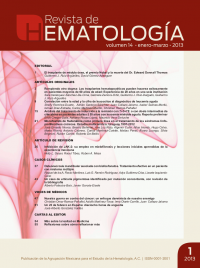RESUMEN
Antecedentes: las leucemias agudas son la principal causa de muerte asociada con neoplasias hemato-oncológicas. Diversas variables afectan su pronóstico de forma individual; la edad y la cifra de leucocitos son las de mayor trascendencia.
Objetivo: establecer una correlación entre la edad y la cifra de leucocitos como dos de las principales variables pronósticas, bajo la hipótesis de que a mayor edad mayor cifra de leucocitos al diagnóstico.
Material y método: estudio transversal y observacional efectuado en pacientes con diagnóstico de leucemia aguda atendidos en el
Hospital General de México y el Hospital General de Cuautitlán entre los años 2006 a 2012. Se efectuó análisis de correlación de Pearson y regresión lineal entre las variables edad y cuenta de leucocitos. Se aplicó prueba de T de Student para diferencias de medias de leucocitos entre leucemia mieloide y linfoide.
Resultados: se estudiaron 441 pacientes, la mayoría con leucemia linfoblástica aguda (n = 279; 63%), leucemia mielomonoblástica aguda (n = 65; 14.7%) y leucemia mieloide aguda con maduración
(n = 44, 10%). La mediana de leucocitos al diagnóstico fue de 44 x 103/mcL (3.1- 682 x 103/mcL). Se encontró una diferencia significativa entre las medias de leucocitos al diagnóstico entre ambas leucemias 105.08 x 103/mcL versus 72.51 x 103/mcL, p=0.009, 95% IC (límites 8.26 y 56.88)]. Al realizar el análisis de correlación de Pearson no se encontró una correlación significativa
(p=0.925,95%IC). Las R 2 de la regresión fueron de 0.005 y 0.000 para leucemia linfoblástica y leucemia mieloblástica, respectiva- mente, sin una relación específica.
Conclusión: la edad y la cifra de leucocitos son variables sin correlación. La distribución de los tipos de leucemia en cuanto a la edad es semejante a otras series; la hiperleucocitosis es la manifestación más frecuente al diagnóstico.
Palabras clave: leucemia, edad, leucocitos
ABSTRACT
Background: Acute leukemia is the most common cause of cancer-related death Many variables impact on the prognosis, but age and white blood count are the most important.
Material and methods: Cross-sectional study conducted in patients with diagnosis of acute leukemia in the Hospital General de México and the Hospital General de Cuautitlan between 2006 -2012.
Statistical Analysis. Pearson correlation test and lineal regression between age and White blood count at the diagnosis. T- test for the mean difference between White blood count of acute lymphoid and acute myeloid leukemia.
Results: 441 were studied, mostly acute lymphoblastic leukemia (N=279,63.3%) followed by acute myelomonoblastic leukemia (n=65,14.7%) and acute myeloid leukemia with maturation. (n=44,10%).
The median white blood cell count at the diagnosis was 44 x 103/mcL (3.1- 682 x 103/mcL). There were differences between the median white blood cell count at the diagnosis between both leukemias (105.08 x 103/mcL versus 72.51 x 103/mcL, p=0.009, 95% IC (range 8.26- 56.88)]. There was no significant difference in the Pearson correlation test ((p=0.925,95%IC). The R square of the linear regression was 0.005 and 0.000 for acute lymphoblastic leukemia and acute myeloblastic leukemia respectively, with no specific relationship.
Conclusion: Age and White blood count are uncorrelated indepen-dent variables. The distribution of the different types of leukemia according to age is the same as other series, hyperleukocytosis is the most common manifestation of acute leukemia.
Key words: Leukemia, age, white blood cell count

